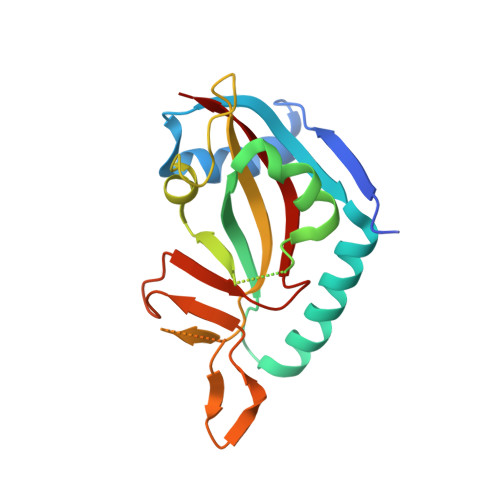Identification of PARP14 inhibitors using novel methods for detecting auto-ribosylation.
Yoneyama-Hirozane, M., Matsumoto, S.I., Toyoda, Y., Saikatendu, K.S., Zama, Y., Yonemori, K., Oonishi, M., Ishii, T., Kawamoto, T.(2017) Biochem Biophys Res Commun 486: 626-631
- PubMed: 28315326
- DOI: https://doi.org/10.1016/j.bbrc.2017.03.052
- Primary Citation of Related Structures:
5V7T, 5V7W - PubMed Abstract:
Poly(ADP-ribose) polymerases (PARPs) use nicotinamide adenine dinucleotide (NAD + ) as a co-substrate to transfer ADP-ribose when it releases nicotinamide as the metabolized product. Enzymes of the PARP family play key roles in detecting and repairing DNA, modifying chromatin, regulating transcription, controlling energy metabolism, and inducing cell death. PARP14, the original member of the PARP family, has been reported to be associated with the development of inflammatory diseases and various cancer types, making it a potential therapeutic target. In this study, we purified the macrodomain-containing PARP14 enzyme and established an assay for detecting the auto-ribosylation activity of PARP14 using RapidFire high-throughput mass spectrometry and immunoradiometric assay using [ 3 H]NAD + . Subsequently, we performed high-throughput screening using the assays and identified small-molecule hit compounds, which showed NAD + -competitive and PARP14-selective inhibitory activities. Co-crystal structures of PARP14 with certain hit compounds revealed that the inhibitors bind to the NAD + -binding site. Finally, we confirmed that the hit compounds interacted with intracellular PARP14 by a cell-based protein stabilization assay. Thus, we successfully identified primary candidate compounds for further investigation.
Organizational Affiliation:
Pharmaceutical Research Division, Takeda Pharmaceutical Company Limited, 26-1, Muraoka-Higashi 2-chome, Fujisawa, Kanagawa 251-8555, Japan. Electronic address: mariko.hirozane@takeda.com.















